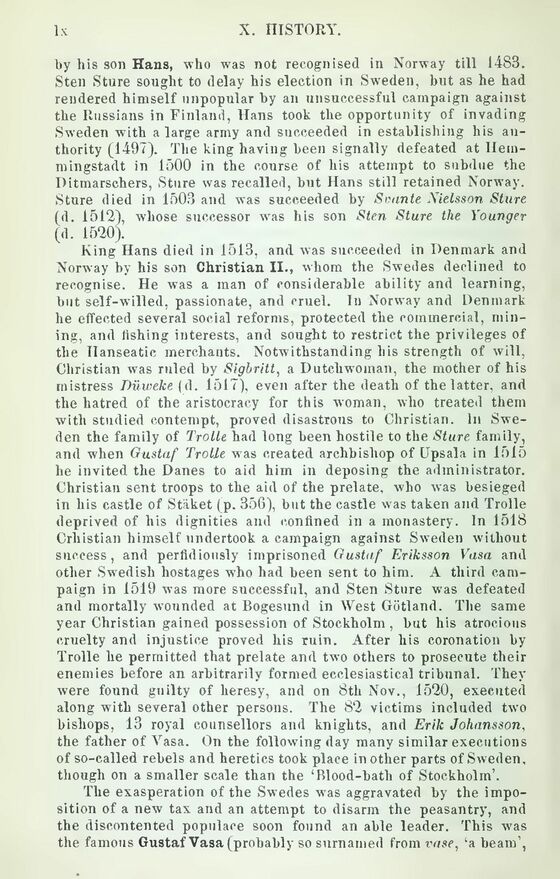
Full resolution (JPEG) - On this page / på denna sida - Introduction - Pages ...

<< prev. page << föreg. sida << >> nästa sida >> next page >>
Below is the raw OCR text
from the above scanned image.
Do you see an error? Proofread the page now!
Här nedan syns maskintolkade texten från faksimilbilden ovan.
Ser du något fel? Korrekturläs sidan nu!
This page has never been proofread. / Denna sida har aldrig korrekturlästs.
by his son Hans, who was not recognised in Norway till 1483.
Sten Sture sought to delay his election in Sweden, but as he had
rendered himself unpopular by an unsuccessful campaign against
the Russians in Finland, Hans took the opportunity of invading
Sweden with a large army and succeeded in establishing his
authority (1497). The king having been signally defeated at
Ilein-mingstadt in 1500 in the course of his attempt to subdue the
Ditmarschers, Sture was recalled, but Hans still retained Norway.
Sture died in 1503 and was succeeded by Svante Nielsson Sture
(d. 1512), whose successor was his son Sten Sture the Younger
(d. 1520).
King Hans died in 1513, and was succeeded in Denmark and
Norway by his son Christian II., whom the Swedes declined to
recognise. He was a man of considerable ability and learning,
but self-willed, passionate, and cruel. In Norway and Denmark
he effected several social reforms, protected the commercial,
mining, and fishing interests, and sought to restrict the privileges of
the Hanseatic merchants. Notwithstanding his strength of will,
Christian was ruled by Sigbritt, a Dutchwoman, the mother of his
mistress Diiweke (d. 1517), even after the death of the latter, and
the hatred of the aristocracy for this woman, who treated them
with studied contempt, proved disastrous to Christian. In
Sweden the family of Trolle had long been hostile to the Sture family,
and when Gustaf Trolle was created archbishop of Upsala in 1515
he invited the Danes to aid him in deposing the administrator.
Christian sent troops to the aid of the prelate, who was besieged
in his castle of Staket (p. 356), but the castle was taken and Trolle
deprived of his dignities and confined in a monastery. In 1518
Crhistian himself undertook a campaign against Sweden without
success, and perfidiously imprisoned Gustaf Eriksson Vasa and
other Swedish hostages who had been sent to him. A third
campaign in 1519 was more successful, and Sten Sture was defeated
and mortally wounded at Bogesund in West Götland. The same
year Christian gained possession of Stockholm , but his atrocious
cruelty and injustice proved his ruin. After his coronation by
Trolle he permitted that prelate and two others to prosecute their
enemies before an arbitrarily formed ecclesiastical tribunal. They
were found guilty of heresy, and on 8th Nov., 1520, executed
along with several other persons. The 82 victims included two
bishops, 13 royal counsellors and knights, and Erik Johansson,
the father of Vasa. On the following day many similar executions
of so-called rebels and heretics took place in other parts of Sweden,
though on a smaller scale than the ‘Blood-bath of Stockholm’.
The exasperation of the Swedes was aggravated by the
imposition of a new tax and an attempt to disarm the peasantry, and
the discontented populace soon found an able leader. This -was
the famous Gustaf Vasa (probably so surnamed from vase, ‘a beam’,
<< prev. page << föreg. sida << >> nästa sida >> next page >>